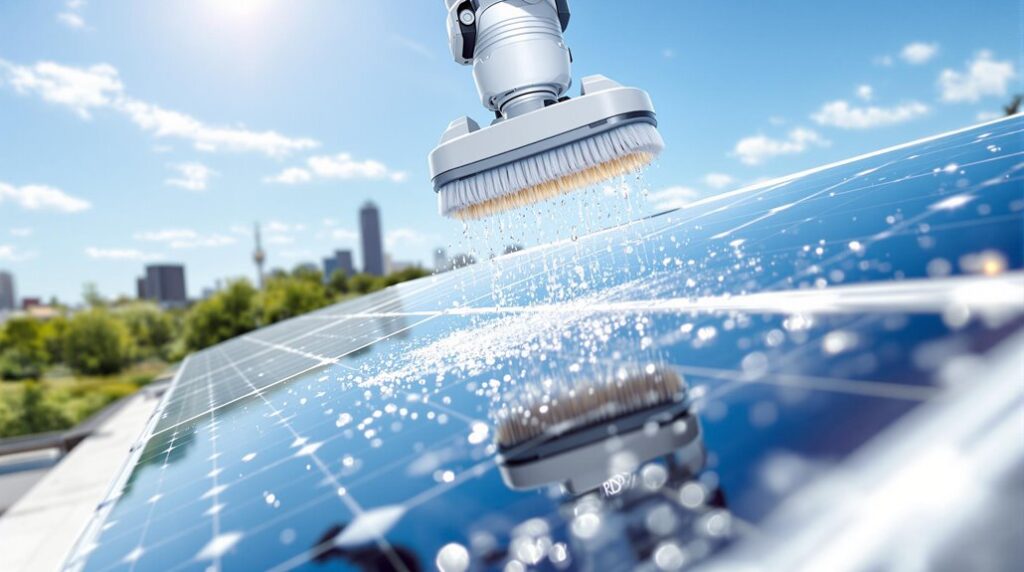I’ve discovered that cleaning solar panels manually is one of the biggest time drains for homeowners seeking maximum energy efficiency. After analyzing various automated solutions, I can tell you that robotic cleaning systems have revolutionized rooftop maintenance by delivering consistent results without the safety risks or physical demands. These AI-powered devices operate independently, ensuring your panels maintain peak performance year-round. What surprised me most about these systems isn’t just their effectiveness—it’s how they transform your entire approach to solar maintenance.
Key Takeaways
- Install permanent robotic systems with rain sensors and integrated solar panels for autonomous 24/7 cleaning operations.
- Deploy AI-powered robots with advanced navigation that handle 45-degree inclines and clean 1000 square meters hourly.
- Utilize water-free cleaning technology with wind-blowing systems to eliminate water costs and environmental impact.
- Implement remote smartphone control for real-time monitoring, scheduling, and maintenance alerts from anywhere.
- Achieve 15-25% energy output improvements while reducing labor costs and eliminating dangerous rooftop access.
Types of Automatic Solar Panel Cleaning Robots for Rooftop Applications
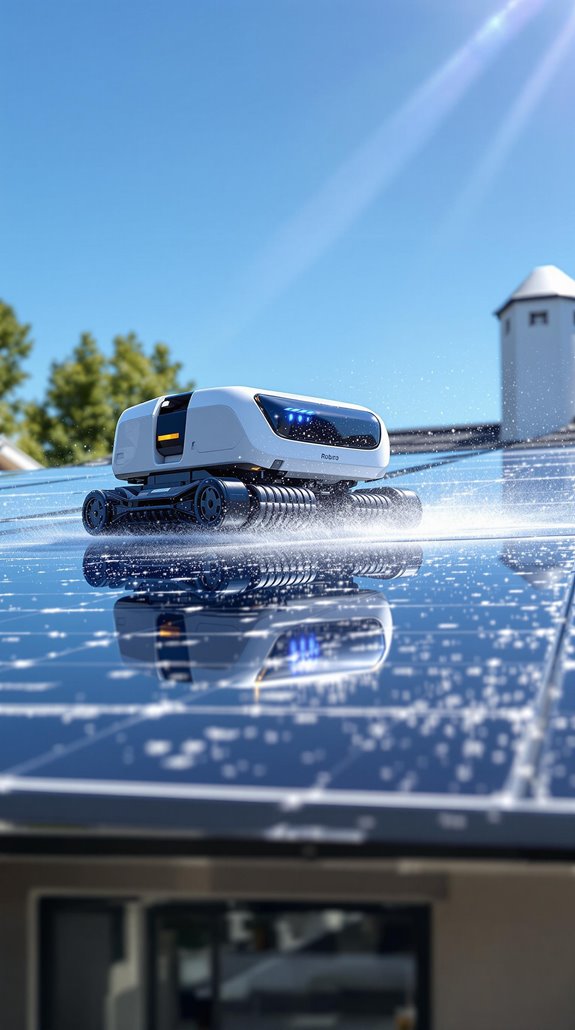
While manual cleaning remains the traditional approach, automatic solar panel cleaning robots have transformed rooftop maintenance by delivering consistent results without human intervention. I’ve found that permanent installation robots offer the most convenience, mounting directly onto your roof with rain sensors and integrated solar panels for autonomous operation. If you’re managing multiple sites, mobile robots are your best bet—they’re portable and clean up to 1000 square meters per hour on inclinations up to 25 degrees. For those wanting cutting-edge technology, AI-powered robots navigate gaps up to 27.5 inches between panels and work 24/7 with LED lighting. Water-free cleaning technology uses wind-blowing systems, perfect for desert conditions where dust accumulates quickly on your monocrystalline panels. Beyond maintaining cleanliness, these automated systems significantly enhance operator safety by eliminating the need for workers to access potentially dangerous rooftop installations.
Advanced Safety Features That Prevent Damage and Accidents
Before investing in automatic solar panel cleaning robots, you’ll need to understand the thorough safety systems that protect both your equipment and property from costly damage. These sophisticated machines integrate multiple detection technologies including cameras, lasers, and ultrasonic sensors for precise obstacle identification. They’ll automatically adjust navigation patterns in real-time to avoid collisions while maintaining cleaning efficiency.
Your robot’s anti-fall protection system prevents dangerous drops from panel edges, while fail-safe mechanisms activate during malfunctions to minimize damage. Boundary sensors keep the unit within designated cleaning zones, ensuring it won’t wander into restricted areas. These systems are built with durable materials to withstand regular cleaning operations and harsh environmental conditions.
The track-based design provides superior stability across glass surfaces and slopes, while robotic arms offer flexible positioning for thorough cleaning without compromising safety or panel integrity.
AI-Powered Navigation and Autonomous Operation Capabilities
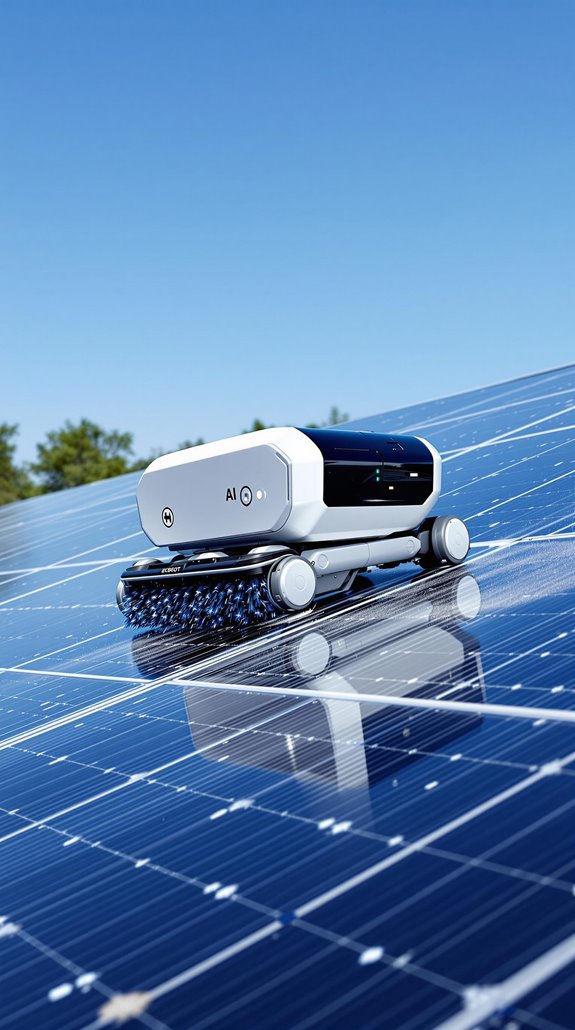
Modern AI-powered solar panel cleaning robots transform maintenance operations by combining sophisticated navigation algorithms with autonomous decision-making capabilities that eliminate human intervention. I’ll show you how these systems work for your solar farm.
The AI algorithms map complex panel layouts automatically, while advanced sensors detect edges and obstacles to prevent falls and damage. Your robots will navigate terrain variations up to 45-degree inclines and cross 50mm gaps between panel rows effortlessly.
The patented precision drive systems guarantee smooth, low-noise operation with dual-pass cleaning mechanisms that increase efficiency. You’ll benefit from 360-degree environmental awareness through cameras and LiDAR, plus automatic deviation correction that maintains straight paths on uneven surfaces. Light-sensitive sensors prevent daytime activation, optimizing your cleaning schedules perfectly. These systems can clean up to 2.2 km of solar panels on a single charge at 14 meters per minute.
Energy Output Recovery and Financial Benefits of Automated Cleaning
Automated solar panel cleaning systems deliver measurable energy output recovery that translates directly into substantial financial returns for your solar investment. I’ve seen these systems restore panel efficiency to near-original levels, achieving up to 95% when cleaned twice annually. In desert climates, IoT-based systems increase power wattage by an impressive 89.33%.
You’ll eliminate the 10% efficiency losses that occur within days after manual cleaning, maintaining peak performance year-round. The financial benefits are compelling: reduced labor costs, eliminated water expenses with waterless technology, and increased energy production that directly boosts your revenue. These systems also contribute to job creation and support local industry growth as the renewable energy sector continues to expand.
With the automated cleaning market exceeding $1 billion in 2024 and projected 7.2% annual growth through 2034, you’re investing in proven technology that protects your solar assets while maximizing returns.
Installation Process and Compatibility With Existing Solar Systems
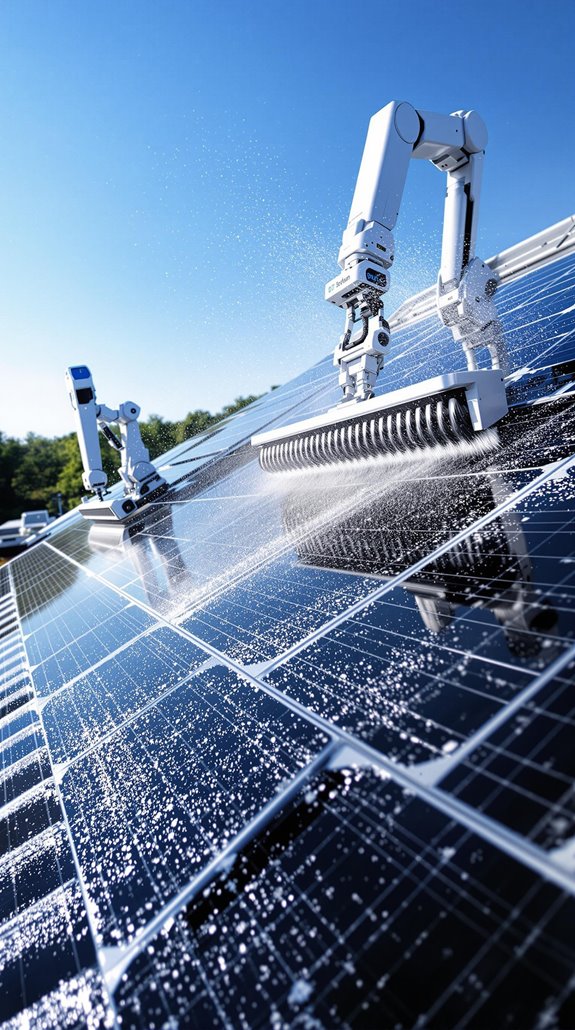
While implementing automated solar panel cleaning systems may seem complex, the installation process integrates seamlessly with your existing solar infrastructure without requiring structural modifications or panel replacements. I’ll guide you through securing weatherproofed docking stations directly onto your panel rails using universal clamps that accommodate both polycrystalline and monocrystalline panels, plus various pipe materials like UPVC and CPVC.
Professional installation typically takes hours to several days, depending on your system’s size. You’ll configure cleaning schedules through a cloud-based portal, calibrate sensors for edge detection, and program ideal cleaning paths. The lightweight robots won’t damage your panels, and WiFi connectivity enables real-time monitoring. Each robot covers up to 2.2 km per charge, making this solution perfect for both residential and commercial installations. The docking stations feature weatherproof design that can withstand wind speeds up to 180 km/hour, ensuring reliable operation in extreme weather conditions.
Environmental Advantages of Chemical-Free Cleaning Methods
Because automated solar panel cleaning systems eliminate harsh chemicals from your maintenance routine, you’re protecting both your investment and the environment through waterless technologies that cut water usage by 90% compared to traditional washing methods. I’ve found that biodegradable plant-based cleaners decompose harmlessly without contaminating soil or water sources, while phosphate-free formulations prevent algal blooms in local waterways.
You’ll preserve local biodiversity by avoiding toxic runoff that threatens pollinators and soil microorganisms. These chemical-free solutions maintain your panels’ ideal light transmittance without leaving residues that attract dirt or cause corrosive damage. Regular cleaning ensures maximum energy efficiency and extends the lifespan of your solar panels. Plus, you’re meeting tightening environmental regulations while qualifying for green certifications like LEED and BREEAM, ensuring your solar investment aligns with sustainability standards.
Performance Metrics and Coverage Areas for Different Robot Models
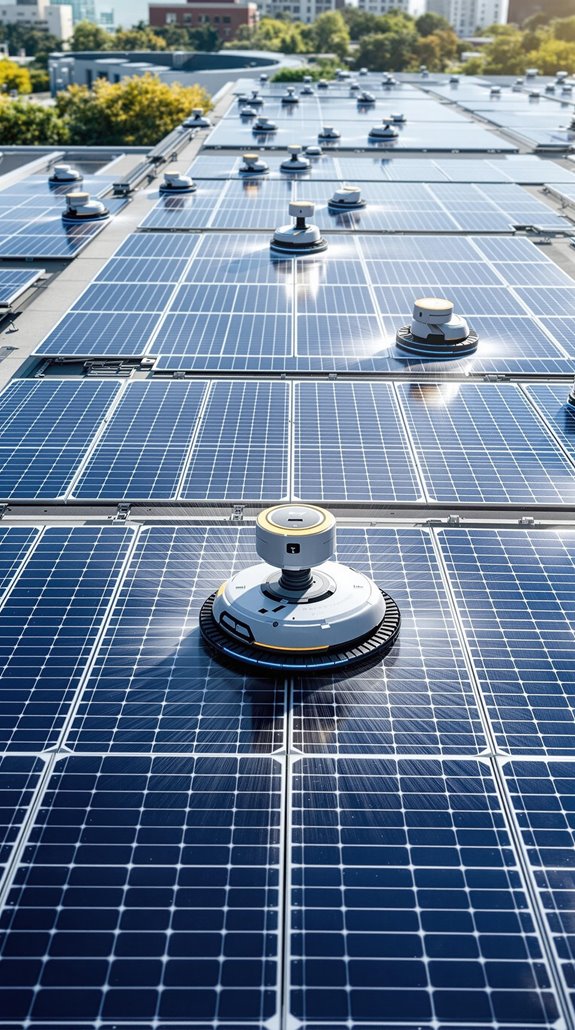
Modern solar panel cleaning robots deliver measurable performance improvements that directly impact your energy production and operational costs. I’ve analyzed the data, and Taypro autonomous waterless robots consistently achieve 15-25% energy output improvements through their systematic cleaning approach. You’ll see the most impressive results with Horizontal Spiral movement methodology, which demonstrates superior accuracy with MAPE scores of 89.81 and minimal deviation rates.
For residential installations, you’re looking at precise coverage of 81.86 m² panels per cycle through GPS-guided navigation. The IoT-enabled path recording guarantees you won’t miss any spots. If you’re in high-dust regions, wet cleaning robots can boost your efficiency by up to 40%. Remember, unclean panels cost you 15-30% energy loss monthly, making these automated solutions essential for maximizing your solar investment.
The dual-pass cleaning technique ensures comprehensive maintenance by first using powerful airflow to remove loose debris, then employing microfiber cloths for stubborn residues.
Remote Monitoring and Control Through Mobile Applications
Through smartphone integration, you’ll control your solar cleaning robots from anywhere with intuitive mobile applications that put complete system management at your fingertips. I’ve found these apps eliminate the guesswork with real-time status updates showing whether your system’s cleaning, idle, or needs attention. You’ll receive instant alerts for maintenance issues, preventing costly downtime.
The beauty lies in customizable scheduling – set cleaning cycles that match your panels’ needs and local weather patterns. Historical data logging helps you track performance improvements, often showing up to 30% energy gains after automated cleaning sessions. You won’t need technical expertise; these interfaces are designed for everyday users like us.
Safety becomes paramount too – no more dangerous rooftop access for manual cleaning when you can optimize everything remotely. Advanced systems like RST NightWash™ operate with no moving parts, enhancing reliability and reducing potential mechanical failures that could interrupt your cleaning schedule.
Maintenance Requirements and Long-Term Operational Costs
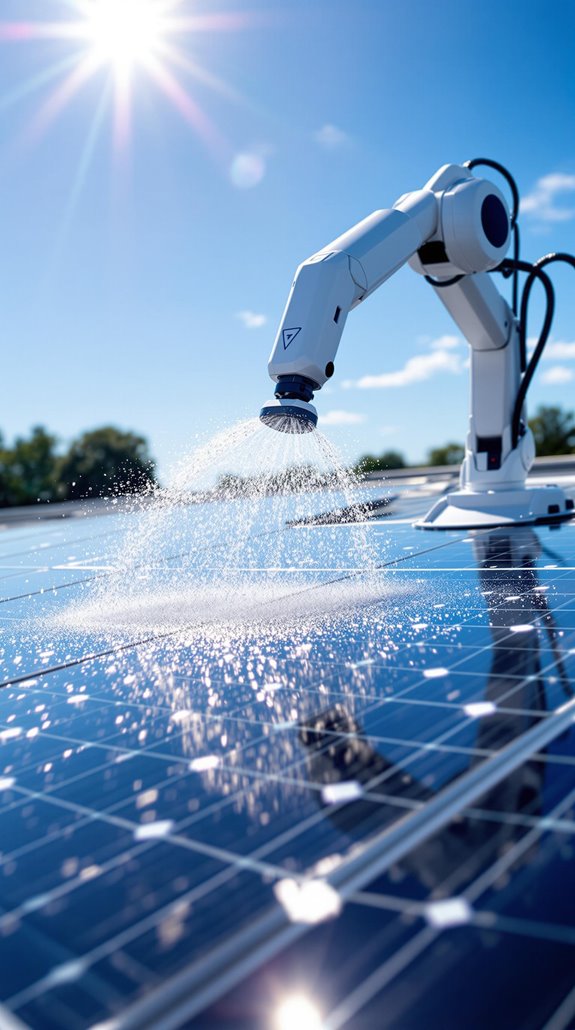
While automated solar cleaning systems reduce hands-on maintenance compared to manual methods, you’ll still need to budget for long-term operational costs that keep your investment performing at peak efficiency.
I recommend planning for inverter replacement every 10-12 years, typically costing thousands. Your panels themselves are incredibly reliable—only 0.05% fail according to NREL studies. However, dirty panels cost you $90 annually on $1,800 savings, totaling $2,250 over 25 years if ignored.
Consider O&M packages at ~$300/year covering cleaning, electrical checks, and pest control. I’ve found extensive plans like Sunsave Plus eliminate surprise expenses through free part replacements. Remote monitoring helps detect performance drops early, enabling timely interventions. The MCS recommends full system inspection every 15 years to ensure optimal performance and identify potential issues before they become costly problems. This proactive approach sustains your ROI while maximizing energy production throughout your system’s 25+ year lifespan.
Conclusion
I’ve shown you how automated solar panel cleaning transforms rooftop maintenance from a time-consuming chore into a hands-off operation. You’ll recover energy losses, cut labor costs, and enhance safety with AI-powered robots that work independently. The installation integrates seamlessly with your existing system, while remote monitoring keeps you informed. You’re investing in efficient technology that pays for itself through improved panel performance and reduced maintenance expenses. Your solar investment deserves this intelligent cleaning solution.
References
- https://www.youtube.com/watch?v=CfbUulJk6x8
- https://windowcleaner.com/collections/solarcleano
- https://www.rst-cleantech.com
- https://www.solarpanelcleaningsystems.com
- https://www.solarpanelcleaningsystem.com/solar-panel-cleaning-system.html
- https://www.ax-solar-robot.com/en/ax-solar-robot-solar-panel-cleaning-robots/
- https://todos-china.com/what-types-of-solar-panels-are-compatible-with-cleaning-robots/
- https://renewableaffairs.com/solar-panel-cleaning-robots/
- https://www.trinarobot.com/news-center/your-quick-guide-to-solar-panel-cleaning-robots.html
- https://hjtpv.com/solar-panel-cleaning/

